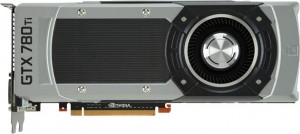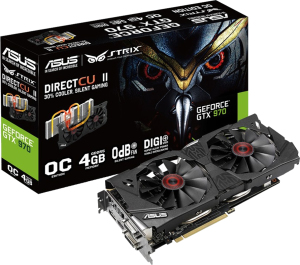 To be honest I was having good time living the heist life in GTA V when the NVIDIA GTX 970/980 were first released, so this comparison came less sooner than usual. But thanks to one good day as I wander and enjoy real life for a brief moment –I stumble upon a GTX 980 for $600. And lo and behold, that’s the story how I met the NVIDIA’s newest and hottest video cards this year.
To be honest I was having good time living the heist life in GTA V when the NVIDIA GTX 970/980 were first released, so this comparison came less sooner than usual. But thanks to one good day as I wander and enjoy real life for a brief moment –I stumble upon a GTX 980 for $600. And lo and behold, that’s the story how I met the NVIDIA’s newest and hottest video cards this year.
Anyway, let’s get straight to the point of the topic and save the random story for another day: what are the great differences between GTX 980 and GTX 970 compared to previous generation GTX 780 and GTX 780 Ti ? Perhaps R9 290X ? What about that new GTX 960 ? Time to find out!
![]() NVIDIA GTX 1070 / GTX 1080 vs Radeon RX 480 – Valar Morghulis
NVIDIA GTX 1070 / GTX 1080 vs Radeon RX 480 – Valar Morghulis
![]() AMD R9 390x and R9 390 versus NVIDIA GTX 980 and GTX 970.
AMD R9 390x and R9 390 versus NVIDIA GTX 980 and GTX 970.
The Architecture
 Ok, if you don’t (or even if you do) consistently keep track with NVIDIA GPU architectures, there is always a time when you wouldn’t be able to recite what the hell each generation and its code-name mean. It’s pretty confusing. Hence this is your captain for the rescue:
Ok, if you don’t (or even if you do) consistently keep track with NVIDIA GPU architectures, there is always a time when you wouldn’t be able to recite what the hell each generation and its code-name mean. It’s pretty confusing. Hence this is your captain for the rescue:
*flies away*
Now we are moving onto something a bit more technical but it’ll bring bright gaming future to your life. Understanding the fundamentals of NIVIDIA’s architectures helps you make a better decision on purchasing their GTX offers for both today and tomorrow. So bear with me.
2. Bear with me (What’s new of GTX 970/980?)

Kepler is the fully evolved version of Fermi.
The first and most high-end Kepler was introduced back in the day was the GTX 680. It uses what NVIDIA calls SMX, or next-generation Streaming Multiprocessor instead of the older Streaming Multiprocessor found in Fermi (GTX 480, for instance, is a Fermi).
Each of the Kepler’s SMX packs 192 CUDA vs. 32 CUDA in Fermi; that means NVIDIA need less SMX to build up the same amount of CUDA cores as they did in a generation before. Therefore, Kepler is a huge improvement in both size, power efficiency and performance when it was released.
Kepler also comes equipped with 512KB-1024KB of L2 Cache, GDDR5 rated at 6,000MHz running on 64-bit memory controllers and a Desktop GPU Boost technology that fluctuates the base speed of 1,006MHz according to processing demand and temperature (similar to Intel’s Turbo Boost).
Now today in what powering the GTX 980 and GTX 970, we have Maxwell.
Maxwell GTX 980 and GTX 970 in particular, is the improvement of the mid-range Kepler series known as GK104 (not the high-end GK110).
As you can see, the GTX 980 and GTX 970 (both in Maxwell GM204 family) are meant to replace the mid-range 700-series (GK104) but not a direct successor of GTX 780 and GTX 780 Ti (GK110). Simply because it’s still based on an old 28nm architecture, but with a newer design (whereas 20nm is already being shipped by TSMC at the time of this meal).
However, that doesn’t mean these two new beasts are any less than GTX 780 and GTX 780 Ti. In fact, one of them is just like Toothless, huge power in a small frame.
But first of all, let’s forget everything about SMX that you may have accidentally read somewhere before. Because here we got the brand new shiny and almighty Maxwell SM design, aka SMM ! (there is something off about the abbreviation here but I can’t tell which). So what are the better? I’m gonna quote NVIDIA on this :
[Maxwell brings] improvements to control logic partitioning, workload balancing, clock-gating granularity, instruction scheduling, number of instructions issued per clock cycle, and many other enhancements allow the Maxwell SM to far exceed Kepler SMX efficiency.
In short, what you could expect from Maxwell series is an excellent power efficiency with equal or slightly greater performance than the high-end of Kepler series. Size don’t change. Period.
Maxwell, Kepler Summary
 GTX 980 and GTX 970 belongs to the high-end Maxwell architecture with code-name GM204. The lower-end GM107 includes GTX 750 and GTX 750 Ti (step up of GK107 and GK106).
GTX 980 and GTX 970 belongs to the high-end Maxwell architecture with code-name GM204. The lower-end GM107 includes GTX 750 and GTX 750 Ti (step up of GK107 and GK106).- Maxwell GM204 — GTX 970 and GTX 980 — are actually a slight change in fundamental design of the Kepler GK104 Series; which is also the family of GTX 680, GTX 760 and GTX 770. Each CUDA core on Maxwell architecture performs from 35 to 40% better than Kepler’s. In proportion, that roughly means the GTX 980 has as many CUDA cores as GTX 780 Ti but with higher, more efficient clock speed and better overclocking potential.
- Maxwell has a larger L2 Cache at 2MB (1.75MB for GTX 970), while Kepler only has 512KB to 1.5MB
 Reference GTX 980 and GTX 970 have a maximum power consumption of 165W and 145W, respectively –both requires only 2 x 6-pin connectors. GTX 980 consumes 85 watts less than GTX 780 and GTX 780 Ti. Hence a SLI setup of them only requires a whooping 650-watt power supply unit!
Reference GTX 980 and GTX 970 have a maximum power consumption of 165W and 145W, respectively –both requires only 2 x 6-pin connectors. GTX 980 consumes 85 watts less than GTX 780 and GTX 780 Ti. Hence a SLI setup of them only requires a whooping 650-watt power supply unit!- GTX 980 has Texture fill rate of 30 gigaflops per watt while GTX 780 is a long way behind at 15 gigaflops per watt.
- Maxwell is especially made to run super high-resolution at 1600p and 4K.
- GTX 770, GTX 780 and GTX 780 Ti are now discontinued.
- Other improvements :
- More efficient DCC algorithms (delta color compression, intellisample)
- Post-process Dynamic Super Resolution effect (GTX 980 and GTX 970 only).
- New Multi-Frame Sampled Anti-Aliasing (MFAA)
- New Voxel Global Illumination (VXGI) — Boy, this is the good stuff! Click here to watch the video NVIDIA made to demonstrate such VXGI, very wow.
- VR Direct
For $150 Less Than GTX 970, Should You Get A GTX 960 ?
 By the end of January 2015, NVIDIA added a new member to the Maxwell 900 series family to compete in the mid-range division.
By the end of January 2015, NVIDIA added a new member to the Maxwell 900 series family to compete in the mid-range division.
The GTX 960, in a similar fashion to GTX 970 and GTX 980, uses the same super power-efficient Maxwell architecture. However, while the two high-end models evolved from Kepler GK104, the GTX 960 is coming from Kepler GK106 of the GeForce GTX 660 –thus the name GM206.
First off, for those who are spoiled with the top of the line in last few months, you may wonder why GTX 960 is such a hobbit compared to the giant GTX 980. Everything that GTX 960 has, is exactly half of what GTX 980 has. The number of CUDA cores on GTX 960 are 1024 versus 2048, 128-bit memory bus versus 256-bit, 2GB of GDDR5 versus 4GB (3.5GB usable) on GTX 980. However on a better note, the GTX 960 fits squarely into a $200 price range. Which is more than chopping the GTX 980’s price from $550~$650 in half.
Finally, as it turns out the GTX 960 performs quite well in the mid-range bracket –as long as you don’t set a ridiculous expectation for a $200 graphics card. Its purpose to replace the GTX 760 is a success in many levels.
In the current mid-range category, we also have R9 280 and R9 285 from Radeon for consideration. The GTX 960 consumes significantly less in power (120W vs. 190W/250W) yet performs shoulder to shoulder with R9 285. It’s also right on the tail of Radeon 7970, GTX 680 and GTX 770 while, again, sipping energy from the wall.
In actual gaming experience, you won’t notice much of a difference but will reap the benefit over the power bill when the month ends. For those who are having a GTX 760 or R9 270X or above, it might be an unnecessary upgrade if you are looking for drastic performance change. For anyone else, you are going to enjoy a faster, more quiet and super energy efficient rig for quite a time to come. Also FYI, GTX 960’s in SLI mode do not run much faster than a single GTX 970, they even lag behind in most tests.
- Windforce 3X Cooling System, Flex Display Technology, GPU Gauntlet, Sorting, Ultra Durable...
- BASE: 1178 MHz / BOOST: 1329 MHz, 1664 CUDA Cores, 4GB GDDR5 memory, 256-Bit memory Bus,...
- Powered by Nvidia GeForce GTX 970 GPU, Integrated With Industry's Best 4GB GDDR5 Memory...
- Features Dual-link DVI-I / DVI-D / HDMI / 3 Display Port, Digital Max Resolution 4096 x...
- Virtual Reality Ready
- DirectX12 Ready
- Gamestream to NVIDIA SHIELD
- EVGA "ACX 2.0" Cooling Technology
- Flex Display Technology(patent-pending)
- Powered by NVIDIA GeForce GTX 980 GPU
- Integrated with industry's best 4GB GDDR5 memory 256-bit memory interface
- WINDFORCE 3X 600W cooling system
 3 Best Gaming Motherboards of The Z97 Series That Don’t Break The Bank
3 Best Gaming Motherboards of The Z97 Series That Don’t Break The Bank
Benchmarks (Reference GTX 970 and GTX 980)
Unigine Heaven 4, 1600p – Max 4xAA |
|
| GTX 980 2-way SLI | 71 fps |
| R9 295X2 | 65 fps |
| Single GTX 980 | 41 fps |
| R9 290X | 38 fps |
| GTX 780 Ti | 40 fps |
| GTX 970 | 36 fps |
| GTX 780 | 35 fps |
Hitman Absolution, 1600p – Max 4xAA |
|
| GTX 980 2-way SLI | 75 fps |
| R9 295X2 | 80 fps |
| Single GTX 980 | 43 fps |
| R9 290X | 49 fps |
| GTX 780 Ti | 45 fps |
| GTX 970 | 40 fps |
| R9 280X | 39 fps |
| GTX 780 | 37 fps |
| GTX 960 | 34 fps |
Tomb Raider 2013, 1600p – Max 4xAA |
|
| GTX 980 2-way SLI | 68 fps |
| R9 295X2 | 55 fps |
| Single GTX 980 | 35 fps |
| R9 290X | 30 fps |
| GTX 780 Ti | 27 fps |
| GTX 970 | 25 fps |
| GTX 780 | 24 fps |
| HD 7970 | 20 fps |
| GTX 960 | 19 fps |
Choosing GTX 970 Graphics Cards
MSI GeForce GTX 970 Overclocked 4GB – Armor 2X Thermal Design (GTX9704GD5TOC)
MSI GeForce GTX 970 Gaming 4GB (GTX970GAMING4G)
|
Gigabyte GeForce GTX 970 G1 Gaming
Gigabyte GeForce GTX 970 G1 Gaming GDDR5 Pcie Video Graphics Card, 4GB
|
ASUS GeForce GTX 970 DirectCU II STRIX Overclocked STXGTX970DC2O4G
ASUS STRIX GeForce GTX 970 Overclocked 4 GB DDR5 256-bit DisplayPort HDMI 2.0 DVI-I Graphics Card
|
 Mid-January 2015 NVIDIA
Mid-January 2015 NVIDIA 












I have a palit GTX 980 jetsteam card and i would like to know how much difference would it make if i add another card 960 palit oc would it make a big difference or not in tom clancy and in other games at ultra settings and 2560×1440 and at 2560×1080 resolution